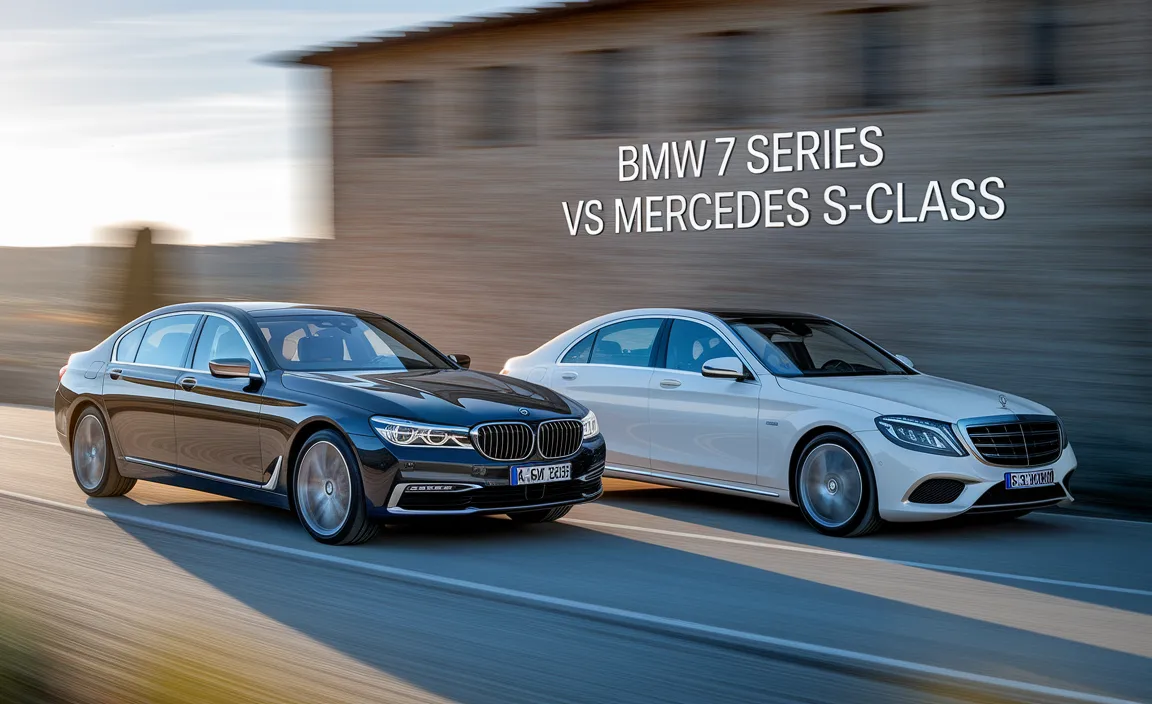At A Glance
The BMW 7 Series and Mercedes-Benz S-Class are titans of luxury sedans. While both offer unparalleled comfort and cutting-edge tech, the S-Class often leads in refined elegance and serene quietness, whereas the 7 Series can offer a sportier, more driver-focused experience. Your choice depends on whether you prioritize ultimate relaxation or dynamic performance in your flagship sedan.
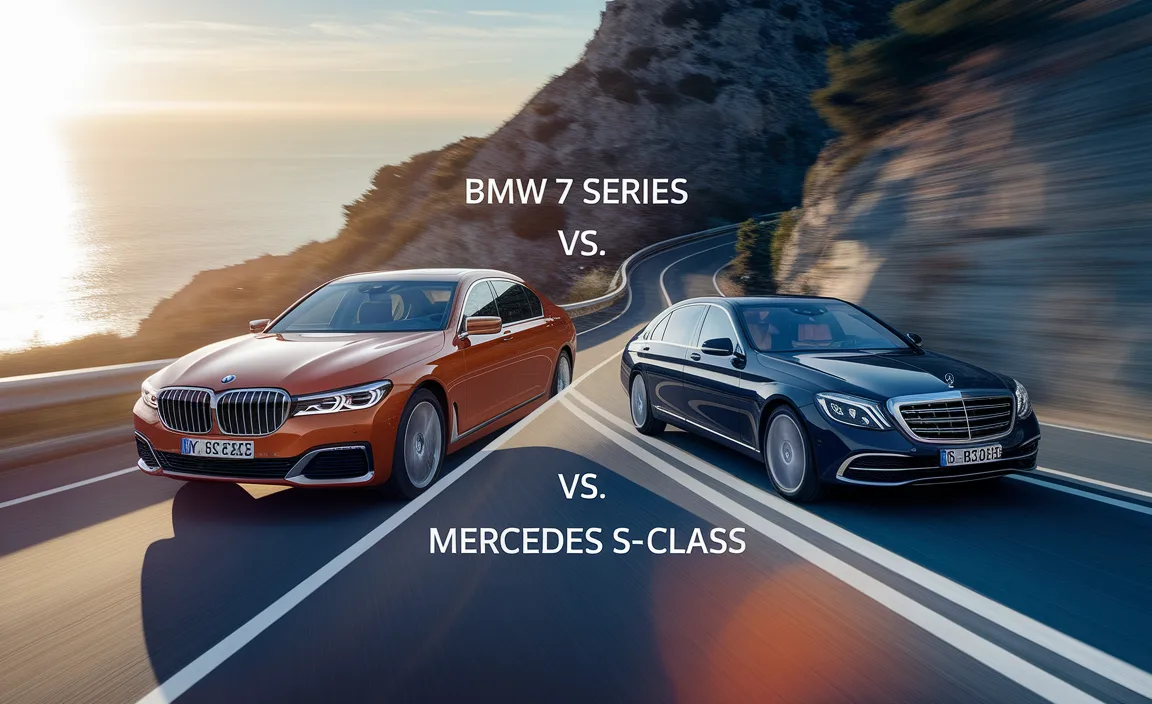
Choosing a luxury sedan is a big decision, and when you’re looking at the absolute best, two names always come up: the BMW 7 Series and the Mercedes-Benz S-Class. These aren’t just cars; they’re rolling statements about success and discerning taste. But how do you decide between these two German powerhouses? It’s a common question, and the good news is, we can break it down simply. We’ll explore what makes each unique, focusing on the features that truly matter to drivers and passengers. Get ready to understand which one might be your perfect fit!
BMW 7 Series vs Mercedes S-Class: The Ultimate Luxury Sedan Showdown
Welcome to the pinnacle of automotive luxury! For decades, the BMW 7 Series and the Mercedes-Benz S-Class have been locked in a sophisticated battle for supremacy in the executive sedan segment. Both represent the very best their respective manufacturers have to offer, packed with advanced technology, sumptuous materials, and impressive performance. If you’re in the market for a car that makes a statement, coddles its occupants, and offers a glimpse into the future of automotive innovation, this comparison is for you.
As your guide on all things Mercedes-Benz, I understand the allure of these top-tier machines. While my heart might have a special place for our three-pointed star, I can appreciate the engineering brilliance across the board. We’ll delve into what sets these two benchmarks apart, helping you understand their strengths and nuances so you can make an informed decision, or simply satisfy your curiosity about the best luxury cars available today.
Let’s explore the key areas where these luxury giants compete and see where each one shines. We’ll look at design, interior comfort, technology, performance, and driving dynamics. Think of this as your friendly walkthrough to understanding the very best in automotive luxury.
Exterior Design: A Matter of Presence
The first impression a car makes is its exterior design. Both the 7 Series and the S-Class aim for a commanding presence, but they achieve it in different ways.
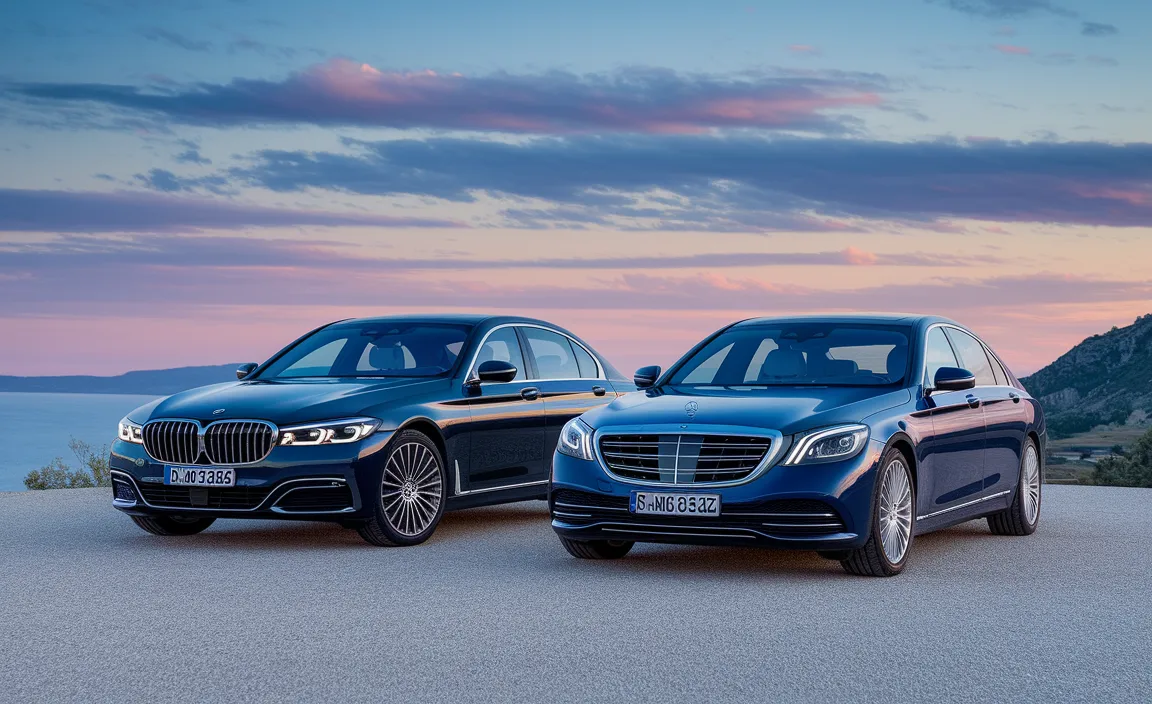
BMW 7 Series Design Philosophy
BMW’s design language with the 7 Series often leans towards a bolder, more assertive look. Recent generations have featured a more prominent kidney grille, sharp character lines, and a generally athletic stance. It’s a design that says, “I’ve arrived,” with a confidence that borders on aggressive. The lines are clean, but there’s an undeniable muscularity.
- Sculpted Lines: Emphasizes a dynamic, athletic profile.
- Prominent Grille: A signature BMW element that communicates power.
- Modern Edge: Often incorporates sharp, contemporary design cues.
Mercedes-Benz S-Class Design Philosophy
The Mercedes-Benz S-Class typically embodies a more timeless and elegant aesthetic. Its lines are usually smoother, more flowing, and exude a sense of understated sophistication. The focus is on graceful proportions and a sense of effortless prestige. It’s the kind of design that commands respect without needing to shout.
- Flowing Silhouette: Graceful curves for an elegant appearance.
- Sophisticated Details: Emphasis on refined chrome accents and lighting.
- Classic Proportions: A timeless look that speaks of enduring luxury.
While subjective, the S-Class often aligns with traditional perceptions of luxury elegance, whereas the 7 Series appeals to those who prefer a more modern and dynamic exterior statement.
Interior Comfort and Ambiance: The Sanctuary
This is where luxury sedans truly justify their titles. The cabins of the 7 Series and S-Class are engineered to be mobile sanctuaries. The differences here often come down to philosophy: Serenity vs. Sophistication.
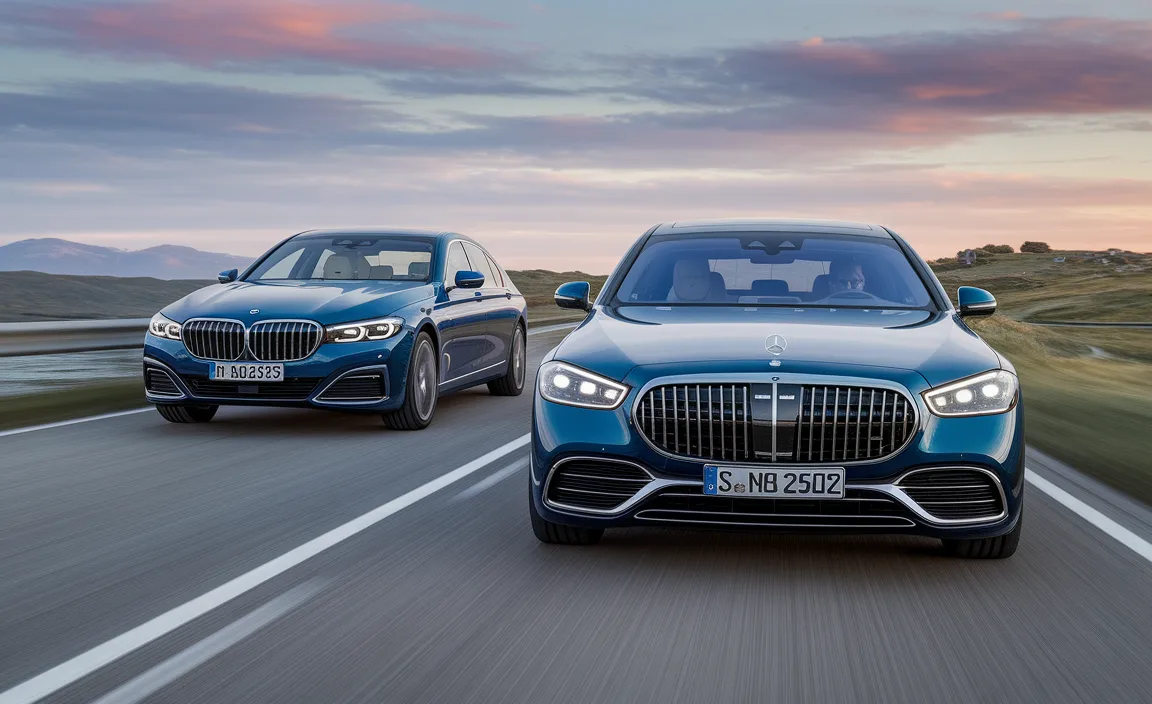
Mercedes-Benz S-Class Interior Experience
Mercedes-Benz has long been recognized for setting the benchmark for S-Class interiors. The focus is on creating an oasis of calm. Expect incredibly comfortable, supremely supportive seats, whisper-quiet cabin insulation that feels almost otherworldly, and an interior ambiance designed for ultimate relaxation. Materials are top-notch, often with exquisite wood veneers, supple leathers, and flawless fit and finish. The MBUX infotainment system, while feature-rich, is integrated seamlessly into the dashboard, often with large, crisp displays that feel intuitive.
- Unrivaled Quietness: Exceptional noise insulation for a serene ride.
- Supreme Seating: Advanced seat designs offering heating, cooling, massage, and extensive adjustability.
- Luxurious Materials: Premium leathers, genuine wood, and meticulous craftsmanship.
- Ambient Lighting: Extensive and customizable ambient lighting creates a bespoke mood.
BMW 7 Series Interior Experience
BMW’s approach in the 7 Series is also about luxury, but often with a slightly more driver-centric feel, even in the rear. The seats are exceptionally comfortable and supportive, available with all the same heating, cooling, and massage functions. The materials are equally premium, with high-quality leathers and fine wood or carbon fiber trim options. BMW often infuses its interiors with a sportier, more modern aesthetic, sometimes featuring more visible technology interfaces.
- Driver-Focused Luxury: While luxurious for all, there’s a subtle emphasis on the driving experience.
- Premium Comfort: Executive seating options with advanced adjustment and massage features.
- High-Quality Finish: Excellent materials and build quality throughout the cabin.
- Advanced Tech Integration: Modern displays and interfaces that are both functional and aesthetically pleasing.
For those who prioritize absolute silence and a serene, almost cocoon-like atmosphere, the S-Class often has a slight edge. The 7 Series offers a wonderfully luxurious experience that still feels more connected to the act of driving, even from the passenger seat.
Technology and Innovation The Future, Today
Both manufacturers are at the forefront of automotive technology, and their flagship sedans are showcases for the latest innovations. This includes advanced driver-assistance systems (ADAS), infotainment, and connectivity.
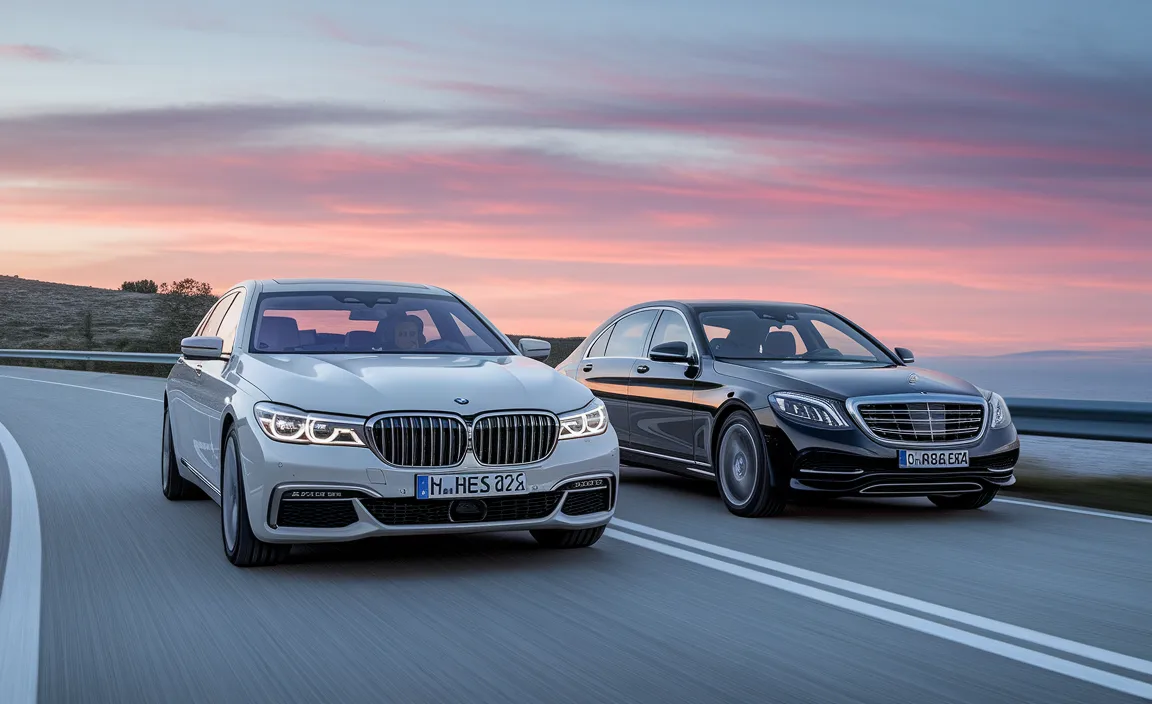
Mercedes-Benz S-Class Technology Highlights
The S-Class is often where Mercedes-Benz debuts its most groundbreaking tech. This includes highly sophisticated driver assistance systems that make long journeys less fatiguing, including advanced adaptive cruise control and lane-keeping assist. The MBUX (Mercedes-Benz User Experience) infotainment system is a star, known for its intuitive voice control (“Hey Mercedes”), augmented reality navigation, and beautiful, high-resolution displays. Rear-seat entertainment options are also typically extensive and well-integrated.
Learn more about the capabilities of modern infotainment systems at the Federal Communications Commission (FCC) BroadbandUSA page for insights into the infrastructure supporting these connected car features.
BMW 7 Series Technology Highlights
BMW doesn’t hold back in the 7 Series. Expect equally advanced ADAS features, often packaged in sophisticated ways that feel natural to use. BMW’s iDrive infotainment system is mature and highly capable, known for its excellent rotary controller combined with touchscreen and voice commands. Recent 7 Series models have introduced impressive features like large rear-seat entertainment screens and advanced connectivity options. BMW’s focus is often on a seamless integration of digital and physical controls.
A key differentiator can sometimes be the interface. Mercedes-Benz often opts for larger, more dominant touchscreens, while BMW might offer a balance with its renowned rotary dial and intelligent voice control. Both allow for wireless Apple CarPlay and Android Auto, and offer a suite of connectivity features for a modern user experience.
Performance and Powertrains: Effortless Pace
Under the hood, both sedans offer a range of powerful and refined engines, prioritizing smooth acceleration and effortless cruising.
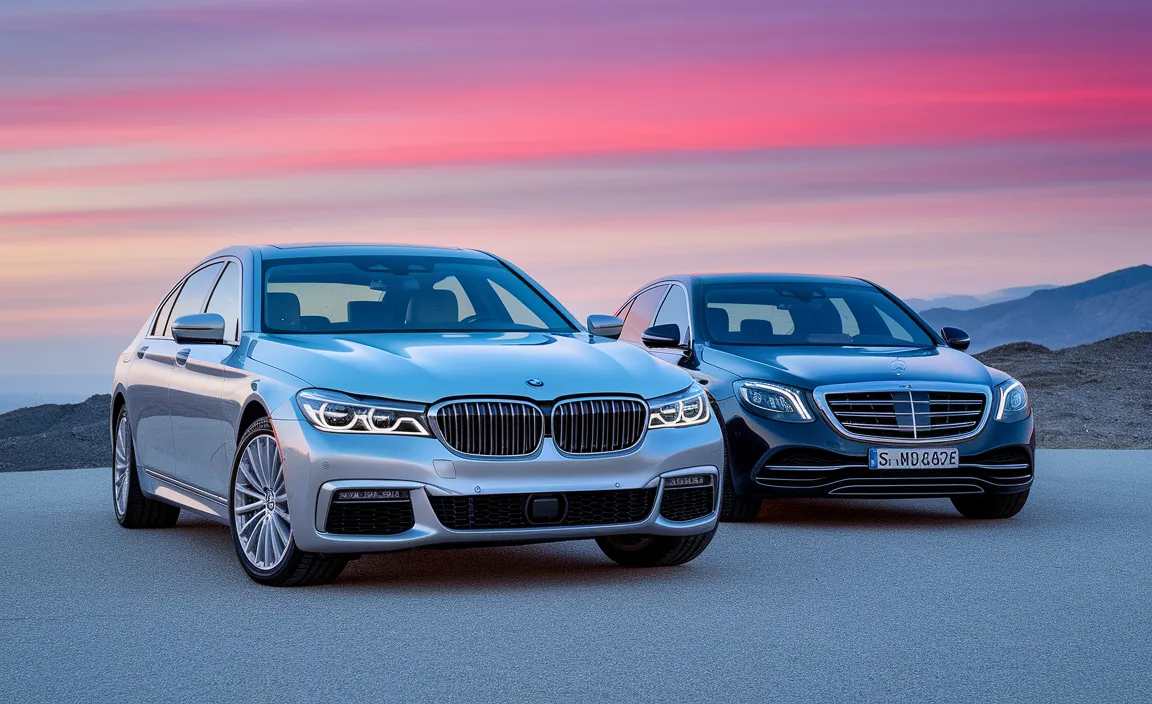
Mercedes-Benz S-Class Powertrain Options
The S-Class typically offers a range of sophisticated inline-six and V8 engines, often incorporating mild-hybrid technology (EQ Boost) for improved efficiency and smoother power delivery. These engines are designed for refined power, providing strong acceleration without any harshness. The suspension systems are a masterclass in comfort, ironing out road imperfections and providing a supremely stable ride. The objective is effortless progress.
- Inline-Six & V8 Engines: Smooth, powerful, and refined.
- EQ Boost (Mild-Hybrid): Enhances efficiency and responsiveness.
- Advanced Suspension: Magic Body Control or AIRMATIC adaptive suspension for unparalleled ride comfort.
BMW 7 Series Powertrain Options
BMW’s 7 Series also boasts potent inline-six and V8 engine options, often with more emphasis on spirited performance. While also smooth and refined, they can feel a touch more responsive and eager than their S-Class counterparts. BMW’s xDrive all-wheel-drive system is often standard or a popular option, enhancing traction and stability. The suspension can be tuned for both comfort and dynamic handling, offering a more engaging driving experience.
- Inline-Six & V8 Engines: Potent and responsive power delivery.
- xDrive All-Wheel Drive: Enhanced grip, especially in adverse conditions.
- Adaptive Suspension: Balances comfort with sporty handling characteristics.
If ultimate, serene comfort is your priority, the S-Class often feels a step ahead. If you enjoy a more connected and engaging drive, even in a large luxury sedan, the 7 Series might appeal more.
Driving Dynamics: Comfort vs. Sportiness
How these large sedans feel behind the wheel is a crucial distinction.
Mercedes S-Class Driving Characteristics
The S-Class is engineered primarily for comfort. Its suspension is superb at isolating occupants from the road, and the steering is typically light and precise, making it easy to maneuver for its size. The goal is effortless gliding. While capable of rapid progress, it prioritizes a smooth, stable, and quiet ride above all else. It’s designed for arriving at your destination feeling refreshed, not fatigued.
- Emphasis on Ride Comfort: Exceptional at smoothing out road imperfections.
- Relaxed Steering: Light and predictable for easy cruising.
- Serene Isolation: Minimal road noise and vibration intrude into the cabin.
BMW 7 Series Driving Characteristics
BMW, with its “Ultimate Driving Machine” heritage, tends to imbue the 7 Series with a more dynamic character. While still incredibly comfortable, the steering often provides more feedback, the suspension is tuned to feel more planted and responsive in corners, and the overall feel can be more engaging for the driver. It’s a better balance of luxury and sportiness, allowing the driver to feel more connected to the road.
- Engaging Handling: More driver-focused feel with better road feedback.
- Responsive Steering: Offers a more connected experience.
- Balanced Performance: Combines luxury with a more dynamic driving capability.
For the chauffeur-driven experience, the S-Class is hard to beat. For the owner who also enjoys being behind the wheel, the 7 Series offers a compelling blend.
Key Differences at a Glance
To help clarify, here’s a table summarizing some common distinctions:
| Feature | BMW 7 Series | Mercedes-Benz S-Class |
|---|---|---|
| Design Ethos | Assertive, dynamic, modern | Elegant, classic, understated |
| Interior Ambiance | Luxurious with a driver-focused feel | Serene, opulent, ultimate comfort |
| Ride Comfort | Excellent, balanced | Often considered class-leading, supremely smooth |
| Driving Dynamics | More engaging, sporty feel | Prioritizes comfort and effortless cruising |
| Infotainment Interface | iDrive (mix of rotary, touchscreen, voice) | MBUX (large screens, prominent voice control) |
| Brand Image | Performance luxury, driver engagement | Timeless luxury, prestige, ultimate comfort |
Real-World Considerations
Beyond the core attributes, there are other factors to consider:
- Rear Seat Experience: Both offer executive rear seating, but the S-Class often feels engineered with the rear passenger’s absolute comfort as a primary goal, sometimes offering more opulent features like reclining seats with leg rests as standard or readily available. The 7 Series is also superb but can feel like a more driver-oriented luxury.
- Infotainment Usability: This is highly subjective. Some prefer Mercedes’ large, visually impressive screens and AR navigation, while others might lean towards BMW’s refined iDrive system with its physical controller for quick adjustments on the move.
- Availability of Features: Both brands offer extensive option lists. It’s wise to research specific model years and trims to see which features are bundled or available. For example, innovative headlights or advanced driver aids might debut on one model before the other.
- Maintenance and Cost: As with any ultra-luxury vehicle, maintenance and repairs will be expensive for both. However, parts availability and specialist knowledge might slightly favour Mercedes-Benz due to its longer history with the S-Class and its widespread dealer network. For an idea of general car part costs, reference resources like those from the U.S. Department of Transportation’s Advanced Vehicle Technology initiatives, which highlight ongoing advancements in automotive componentry.
Which One Is Right for You?
The choice between the BMW 7 Series and the Mercedes-Benz S-Class ultimately boils down to personal preference and priorities:
- Choose the Mercedes-Benz S-Class if: You prioritize ultimate ride comfort, a supremely quiet and serene cabin, and timeless, elegant luxury. You enjoy being chauffeured or want the most relaxing driving experience possible.
- Choose the BMW 7 Series if: You appreciate luxury but also want a more engaging driving experience. You prefer a bolder, more modern design and enjoy the feeling of being more connected to the road when you’re behind the wheel.
Both vehicles are engineering marvels and represent the pinnacle of what mainstream luxury sedans can offer. Test driving both is essential. Drive them on your typical routes, pay attention to the details, and see which one truly speaks to you and your lifestyle.
Conclusion
The perennial rivalry between the BMW 7 Series and the Mercedes-Benz S-Class offers discerning buyers two incredible options at the zenith of automotive luxury. The S-Class stands as a testament to refined elegance, unparalleled quietness, and supreme comfort, making it the ultimate choice for those who prioritize a serene and sophisticated journey. On the other hand, the BMW 7 Series delivers luxury wrapped in a more dynamic and driver-focused package, appealing to those who appreciate performance and engagement alongside their opulence.
Ultimately, the “proven luxury” that defines these titans is subjective. It’s proven in the S-Class’s ability to create an oasis of calm and in the 7 Series’s talent for blending comfort with exhilarating performance. Your perfect choice will depend on whether you envision yourself being chauffeured in absolute tranquility or gripping the wheel for an engaging, yet supremely comfortable, drive. Whichever you choose, you are selecting a vehicle that is a masterpiece of engineering, design, and automotive luxury.
Frequently Asked Questions
Q1: Is the Mercedes S-Class significantly more luxurious than the BMW 7 Series?
A: Both are exceptionally luxurious. The S-Class often emphasizes a serene, opulent, and supremely comfortable experience, while the 7 Series offers a luxurious feel with a slightly more driver-focused or sportier edge. It’s more about the type of luxury you prefer.
Q2: Which car is better for being driven in (rear passenger comfort)?
A: Traditionally, the Mercedes-Benz S-Class has been considered the benchmark for rear-seat comfort, offering a more isolated and relaxing experience. However, the BMW 7 Series also provides opulent rear seating with many premium features.
Q3: Are the technology features in the S-Class and 7 Series comparable?
A: Yes, both vehicles are packed with cutting-edge technology, including advanced driver-assistance systems, impressive infotainment, and connectivity options. The interface and specific features may differ based on model year and trim.
Q4: Which sedan offers a sportier driving experience?
A: The BMW 7 Series generally offers a more dynamic and engaging driving experience, with sharper handling and more driver feedback, aligning with BMW’s “Ultimate Driving Machine” ethos. The S-Class prioritizes comfort and effortless cruising.
Q5: Are maintenance costs very different between the two?
A: Maintenance and repair costs for both ultra-luxury sedans will be high. While specific costs vary, expect them to require significant investment. It’s always wise to budget for premium maintenance for either vehicle.
Q6: Which car is more reliable?
A: Both brands have a strong reputation for building high-quality vehicles, but reliability can vary by model year and specific components. Checking independent reliability ratings for specific model years you are considering is recommended.
